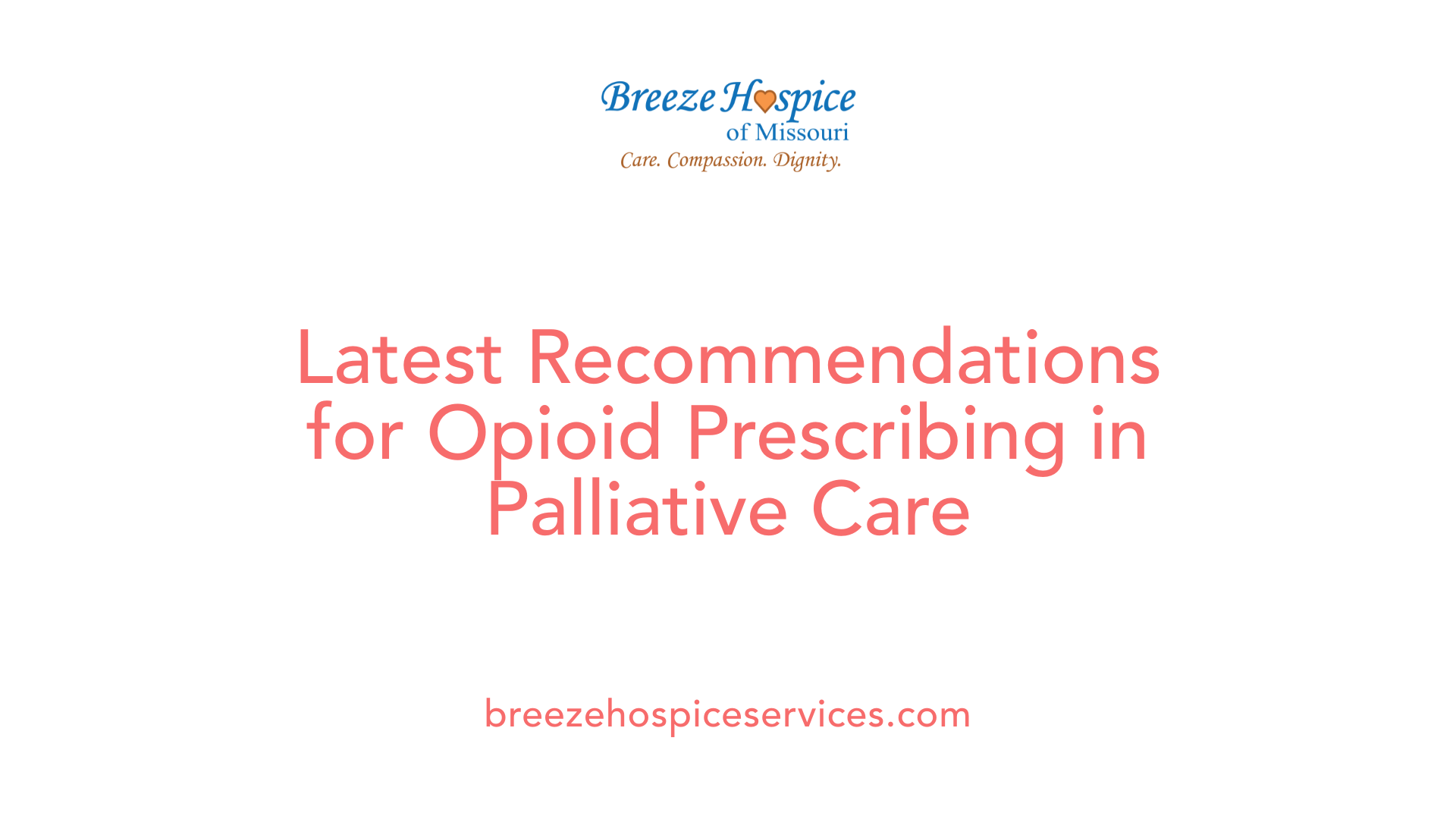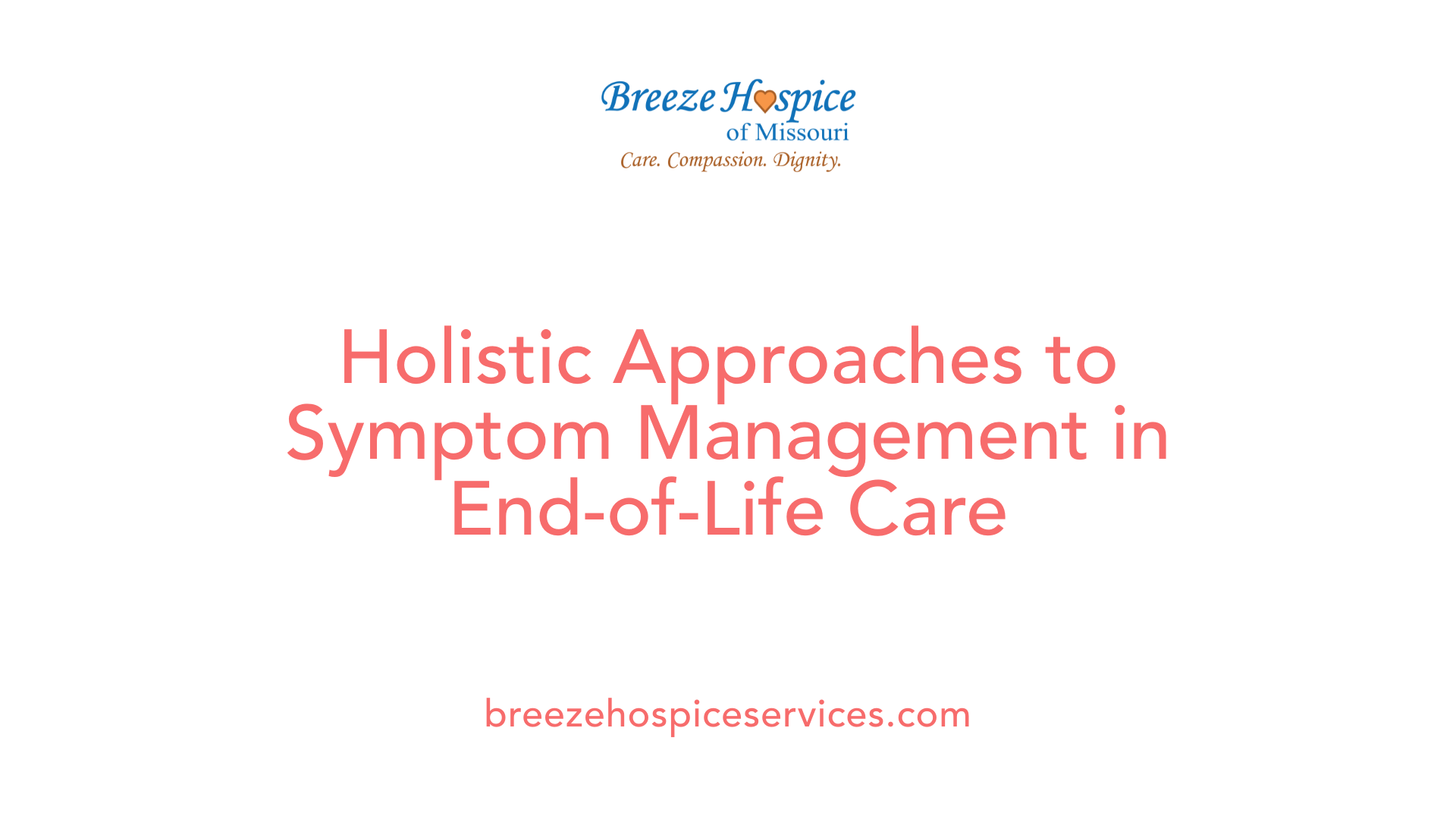Guidelines for Using Opioids in Hospice Care
April 7, 2025
Optimizing Comfort: Opioid Use in Hospice Settings

Introduction to Opioid Use in Hospice Care
The effective management of pain and symptoms is at the heart of hospice care, where the primary aim is to maximize patient comfort in their final months. Opioids play a crucial role in this process due to their powerful analgesic properties. However, their use requires careful consideration of guidelines and clinical best practices to ensure patient safety and optimal outcomes. This article delves into the guidelines for prescribing and managing opioid therapy in hospice care, addressing critical themes such as patient-centered care, safety, and ethical considerations.
Prescription Guidelines and Management

What are the latest guidelines for prescribing opioids in hospice and palliative care?
The 2022 Centers for Disease Control and Prevention (CDC) guidelines suggest that clinicians prescribe opioids at the lowest effective dose, particularly for scenarios warranting opioid use. This patient-centered approach is crucial in hospice and palliative care settings, where the aim is to provide comfort without hastening death.
What strategies are in place to reduce the risk of opioid abuse?
To combat the rising concerns around opioid misuse, the new guidelines emphasize several strategies:
- Thorough evaluation: Assess patients individually to determine the appropriate level of opioid therapy.
- Education: Clinicians should educate patients and families about the treatment’s effectiveness and potential side effects, addressing fears of addiction.
- Monitoring prescriptions: Utilize resources like the Ohio Automated Rx Reporting System (OARRS) to track patient prescriptions and restrict maximum durations of use (7 days for adults, 5 days for minors).
Why is it important to prescribe opioids at low effective doses?
Initiating opioid therapy at the lowest possible dosage is essential for several reasons:
- It reduces the risk of adverse effects, requiring regular monitoring and adjustments based on individual patient responses to treatment.
- Frequent reassessments ensure dosages are aligned with pain management goals, enhancing patient comfort while minimizing the potential for side effects linked to higher doses.
- This practice is particularly crucial for patients with a history of substance use disorders, necessitating careful management and potential collaboration with specialists for optimal outcomes.
Overall, these guidelines aim to foster effective pain management rooted in compassion and appropriateness, respecting the dignity of patients in their final stages of life.
NICE Guidelines on Strong Opioids

What are the NICE guidelines for using opioids in palliative care?
NICE guidelines emphasize the use of oral morphine as the first-line strong opioid for managing pain in patients with advanced cancer. This is due to its effectiveness and broad acceptability among clinicians, allowing for more straightforward dosing and administration.
What is the opioid switching process?
When transitioning a patient from one opioid to another, it is essential to follow a structured switching process. This involves a thorough assessment of the patient’s current opioid usage, including both long-acting and breakthrough doses. The aim is to ensure that the patient experiences continuous pain relief while avoiding potential overdose or withdrawal symptoms.
A dose reduction of 25-50% is usually recommended when calculating the new opioid dosage. This reduction is particularly important for patients considered high-risk, whose previous therapy may have caused side effects or insufficient relief.
How is the dose calculated and what is equivalency?
Accurate calculation of the total daily opioid dosage is critical before initiating any switch. Clinicians should utilize reliable dosing tools specifically designed for palliative care to estimate the equivalent dose of the new opioid. By doing so, they ensure that the transition accommodates each patient's unique pain management needs.
In summary, adherence to these guidelines aims to provide individualized, effective pain management in palliative care settings, emphasizing safety and patient comfort throughout their treatment journey.
Oxycodone Use and Precautions

What are the guidelines for using oxycodone?
Oxycodone is a potent opioid analgesic, primarily prescribed for the management of severe acute pain when other pain relief options have been ineffective. Its effectiveness necessitates strict adherence to the prescribed dosage to mitigate the risks of overdose and addiction.
Patients should be particularly cautious during the initial treatment phase, as well as after any dosage adjustments. Serious respiratory complications can arise, especially within the first 24 to 72 hours of treatment. It is essential to monitor how the body responds during this period effectively.
Secure storage and disposal
The safe handling of oxycodone extends beyond administration. Proper storage in a secure location is critical to prevent unauthorized access, particularly by children. After medication use, unused pills should be disposed of correctly to avoid potential misuse or accidental ingestion.
It's advisable to consult local pharmacy guidelines for safe disposal methods or utilize drug take-back programs to prevent environmental contamination. The combination of secure storage and appropriate disposal practices helps safeguard others and promotes responsible medication use.
For thorough education on oxycodone's effects, risks, and best practices, the MedlinePlus page on oxycodone provides comprehensive and reliable information.
Initial Opioid Recommendations
What is the initial opioid recommendation for pain treatment in palliative care?
In the context of palliative care, effective pain management begins with opioids for patients experiencing moderate-to-severe pain. For opioid-naïve patients, the initial recommendation is to start with morphine, typically prescribed at a dosage of 2.5-5 mg orally every 4 hours. For subcutaneous administration, the dose should be half of the oral dose administered, ensuring appropriate titration for the specific route.
Alternatives to Morphine
While morphine remains the primary choice for many, clinicians may also consider hydromorphone or oxycodone as equianalgesic alternatives, especially when individualized patient circumstances require it. The selection of an opioid should take into account the patient's previous history of drug use, potential for adverse reactions, and personal preferences regarding pain management.
Management of Opioid-Induced Constipation
An essential component of opioid therapy is the management of side effects, notably opioid-induced constipation, a common issue in patients receiving these medications. To prevent constipation, it is crucial to implement a bowel protocol alongside regular opioid prescriptions. This may include the use of stool softeners, laxatives, or medications like methylnaltrexone or naloxegol, which are recommended to alleviate constipation after first-line therapies. Careful monitoring and adjustment of both pain and bowel management therapies are vital to ensure optimal patient comfort while minimizing risks from opioid use.
Comprehensive Symptom Management

Symptom Assessment Protocols
At the end of life, effective symptom management is crucial for enhancing patient comfort. A comprehensive, evidence-based approach is recommended, encompassing continuous assessment of various symptoms like pain, dyspnea, and anxiety. Nursing orders mandate regular evaluations to address any emerging discomfort promptly. This proactive strategy helps in minimizing variability in care and ensures timely intervention.
Moreover, documentation plays a vital role in this process. Detailed records of medication administration, symptom progression, and patient feedback are essential for delivering optimal care.
Use of Non-Opioid Medications for Anxiety and Nausea
In addition to opioids, managing anxiety and nausea is critical in palliative care. Medications such as Lorazepam are prescribed for anxiety management, while Haloperidol may be used to alleviate nausea and agitation. These medications are crucial for patients who may experience distressing symptoms that could hinder their overall comfort.
Combining both pharmacological and non-pharmacological approaches, including counseling and hydration, enhances the quality of care. This holistic method ensures that all aspects of patient comfort are addressed effectively, allowing for a more compassionate end-of-life experience.
Understanding Opioid Titration and Rotation
Importance of Individualized Dosing
Individualized dosing of opioids is vital in managing pain at the end of life. Each patient's response to pain medication can vary significantly due to differences in individual physiology and the nature of their illness. The best practice is to initiate opioid therapy at the lowest effective dose, regularly assessing effectiveness and adjusting accordingly.
For patients experiencing moderate-to-severe pain, particularly related to cancer treatment, opioids like Morphine or Hydromorphone should be considered. The titration process typically involves frequent evaluations to ensure analgesia goals are met without unnecessary side effects, enhancing overall patient comfort.
Guidelines for Opioid Rotation
When patients do not achieve adequate pain relief or encounter adverse effects from their current opioid therapy, opioid rotation may be necessary. This practice involves switching from one opioid to another to optimize pain management while minimizing side effects.
Here are the key guidelines for opioid rotation:
| Guideline | Description | Example Opioids |
|---|---|---|
| Titration Methodology | Begin with a lower dose of the new opioid (50%-75% of the calculated dose). | Morphine, Hydromorphone, Fentanyl |
| Patient Monitoring | Continuous assessments must follow any change in opioid therapy. | Adjust based on reported pain levels. |
| Breakthrough Pain | Prescribe immediate-release opioids at 5%-20% of the daily morphine equivalent. | As an example, if the patient is prescribed 100 mg of morphine daily, offer 5-20 mg of immediate-release morphine for breakthrough pain. |
By thoughtfully managing titration and rotation processes, healthcare providers can work towards achieving better pain control and improved quality of life for patients nearing the end of life.
Managing Breakthrough Pain
Immediate-release opioids
Managing breakthrough pain—a sudden flare of pain that occurs despite ongoing opioid treatment—requires prompt intervention. When patients are on chronic opioid therapy, immediate-release opioids are recommended to effectively address this issue. A common approach is to prescribe immediate-release opioids at a dose ranging from 5% to 20% of the patient's total daily morphine equivalent dose. This strategy allows for timely relief, improving quality of life for patients experiencing unexpected pain fluctuations.
Managing chronic opioid therapy
Chronic opioid users may face challenges related to inadequate pain relief or adverse side effects. In such cases, opioid rotation can be beneficial. This involves switching from one opioid to another to enhance pain control and minimize side effects. Regular monitoring of the patient's pain levels and side effects is critical to adjust treatment approaches. Adopting a compassionate, patient-centered approach ensures that each individual receives tailored care that aligns with their specific pain management needs.
| Pain Management Aspect | Recommended Actions | Notes |
|---|---|---|
| Immediate-release opioid usage | Prescribe based on 5%-20% of daily morphine equivalent | Should be readily accessible for breakthrough pain relief |
| Chronic therapy adjustments | Consider opioid rotation when necessary | Important for improving overall pain management effectiveness |
| Monitoring and assessment | Frequent evaluations to guide treatment modifications | Ensures alignment of pain management with changing patient needs and responses |
Clinical Best Practices and Protocols
Timely and effective care
At the end of life, it is essential to implement a comprehensive and evidence-based approach for managing symptoms. This method ensures timely and effective care tailored to each patient's needs. Continuous assessment of symptoms such as pain, dyspnea, and anxiety allows healthcare providers to make informed decisions.
Focusing on patient comfort is paramount. Nursing orders should include specific guidelines for the documentation and administration of medications, particularly opioids like Morphine, Hydromorphone, and Fentanyl, ultimately aiding in pain management while prioritizing patient goals.
Reducing care variability
Reducing variability in care is a crucial component of effective end-of-life management. Implementing standardized protocols facilitates consistent symptom assessment and management. For instance, the World Health Organization's cancer pain ladder serves as an invaluable framework, advising the progression from nonopioids to strong opioids based on the severity of pain.
Furthermore, opioid prescribing guidelines advocate for individualized dosing and titration, adapting to the specific reactions of each patient. This tailored approach, along with interventions focusing on preventing side effects, ensures optimal treatment outcomes for patients experiencing significant pain.
| Topic | Description | Importance |
|---|---|---|
| Timely and Effective Care | Comprehensive symptom management for patient comfort | Enhances quality of life at end-of-life |
| Reducing Care Variability | Standardized care protocols to ensure consistency in managing symptoms | Aids in delivering effective and reliable care |
Safety Considerations and Adverse Effects
Monitoring Side Effects
Monitoring is vital when administering opioids to ensure patient safety and comfort. Regular assessments help identify adverse effects early, which may include:
- Constipation: A common side effect requiring proactive management, such as a bowel protocol.
- Sedation: Patients may experience excessive drowsiness; constant monitoring is essential.
- Respiratory Depression: Serious side effects that necessitate close evaluations, especially in those receiving high doses or with prior opioid use disorders.
Clinicians are encouraged to offer education on recognizing side effects and strategies for mitigating them, promoting patient awareness and involvement in their care.
Preventing Opioid Misuse
Preventing misuse of opioids is critical, especially in vulnerable populations, such as those with a history of substance use disorders. Key strategies include:
- Informed Consent: Mandatory for minors, ensuring understanding and agreement to treatment.
- Tracking Usage: Utilizing systems like the Ohio Automated Rx Reporting System (OARRS) to monitor patient prescriptions and avoid issues like ‘doctor shopping’.
- Limiting Prescription Length: New guidelines recommend restricting the duration of opioid prescriptions post-surgery to minimize risks of dependency.
This proactive approach in monitoring patients and managing medications helps maintain a balance between effective pain relief and minimizing the risks associated with opioid therapy.
Special Considerations for Patients with Substance Use Disorder
Collaboration with specialists
Managing pain for patients with a history of substance use disorder requires a tailored approach. Collaboration with addiction specialists can play a crucial role in formulating a comprehensive pain management strategy. This multidisciplinary teamwork helps in minimizing the risk of opioid misuse while ensuring effective pain relief.
Customized pain management strategies
It is essential to individualize pain management for these patients. Initial opioid dosing should start low, with careful assessments leading to titrations based on pain responses. Non-opioid therapies should be considered first, using opioids as a last resort. Additionally, clinicians must maintain close monitoring for signs of opioid misuse or side effects, offering patients education on risks and alternative pain relief strategies.
Key Strategies in Opioid Administration
| Strategy | Detail | Outcome |
|---|---|---|
| Use of non-opioid therapies | Explore alternatives before opioids | Reduced misuse risk |
| Regular reassessment | Frequent evaluation of pain and side effects | Optimized comfort |
| Shared decision-making | Involvement of patients in treatment plans | Enhanced cooperation |
The aim is to balance pain control while respecting the challenge of a patient's addiction history, always prioritizing their comfort and safety.
Legal and Ethical Aspects of Opioid Prescribing
Informed Consent
In the realm of opioid prescribing, particularly for minors, informed consent is a critical legal requirement. Special attention must be given to obtain consent from a parent or guardian, especially in non-emergency situations. While prescription exemptions exist for specific medical emergencies, ensuring families understand the implications of opioid therapy remains paramount. This process not only protects the patient but also safeguards healthcare providers from legal repercussions.
Prescribing Practices under Regulations
Regulatory bodies underscore the necessity for prescribers to adhere to strict guidelines when distributing opioids, primarily to mitigate risks associated with misuse and addiction. For instance, the new acute pain management guidelines limit opioid prescriptions, advocating a maximum of seven days for adults and five days for minors. Moreover, prescribers are encouraged to utilize resources such as the Ohio Automated Rx Reporting System (OARRS) to monitor patient usage of controlled substances. This proactive approach ensures patient safety and serves to counteract the potential for ‘doctor shopping’ practices.
| Aspect | Requirement | Implication |
|---|---|---|
| Informed Consent | Mandatory for minors; exemptions under certain conditions | Legal protection for providers; informed decision-making. |
| Prescription Limits | Maximum of 7 days for adults, 5 for minors | Reduces risks of addiction and promotes cautious prescribing. |
| Monitoring Usage | Use of OARRS to track prescriptions given | Mitigates abuse and ensures safety in opioid management. |
The careful orchestration of these factors underlines the ethical commitment to patient welfare while navigating the complexities of opioid prescriptions at the end-of-life.
The Role of Nonpharmacological Interventions
Counseling and Hydration
Incorporating nonpharmacological interventions such as counseling plays a critical role in managing pain and symptoms at the end of life. These approaches enhance the overall well-being of patients by addressing emotional, psychological, and spiritual needs.
Counseling techniques can include providing emotional support, engaging patients in discussions about their treatment goals, and facilitating communication with family members. This helps patients express their fears and concerns, leading to greater comfort and dignity in their final days.
Hydration is another essential aspect of end-of-life care. Ensuring that patients are hydrated can alleviate discomfort, particularly in those who may experience dry mouth or fatigue. Proper hydration can improve overall comfort significantly and support the efficacy of other pain management strategies.
Holistic Patient Care
Holistic care goes beyond treating the physical symptoms of pain. It encompasses all aspects of a patient’s experience, recognizing their individuality and personal preferences. By using a combination of pharmacological and nonpharmacological measures, healthcare providers can create a tailored care plan that meets the specific needs of each patient.
This comprehensive approach emphasizes the importance of integrating psychosocial support and nutritional care alongside traditional medical interventions to ensure maximum comfort and quality of life.
Education and Training for Healthcare Professionals

Importance of Pain Education
Effective pain management, particularly at the end of life, hinges on the education of healthcare professionals. Many palliative care physicians recognize the necessity of comprehensive training regarding opioid prescriptions and their associated regulations. Surveys indicate that about 70% of surveyed palliative care physicians stated that their prescribing patterns are not influenced by social issues related to opioid use, which emphasizes the need for clinical education over societal pressures.
Moreover, 95% agreed that future regulations should primarily focus on non-cancer pain, clearly distinguishing between varied pain management needs. This highlights the ongoing need for informed professionals capable of navigating the complexities of opioid therapy, especially considering the distinct requirements of cancer versus non-cancer patients.
Regulatory Insights and Education Responsibility
The Korean Society for Hospice and Palliative Care, per survey results, is viewed as pivotal in addressing educational gaps regarding opioid regulations. Their role could enhance awareness around the intricacies of prescribing practices in hospice settings, leading to better patient outcomes. Effective educational initiatives should encompass pharmacological approaches along with the interpretation of current regulatory frameworks.
These strategies enable healthcare professionals to make informed decisions regarding opioid therapy, ensuring a holistic approach to pain management that prioritizes patient comfort while adhering to safety standards.
| Education Focus Area | Importance | Responsibility |
|---|---|---|
| Pain Management Techniques | Ensures effective patient care | Healthcare Institutions |
| Regulatory Compliance | Avoids legal issues and enhances safety | Medical Associations |
| Communication Skills | Improves patient-provider interactions | Training Programs |
| Interdisciplinary Collaboration | Supports comprehensive care | Healthcare Teams |
Compassionate Care and Shared Decision-Making
Patient preferences in treatment
Integrating patient preferences into treatment plans is a fundamental aspect of compassionate care, especially at the end of life. It is essential for healthcare providers to engage patients in discussions about their values and goals in managing pain and other symptoms. This shared decision-making process not only respects patient autonomy but also enhances their comfort during distressing times.
Healthcare professionals can utilize a collaborative approach where patients express their individual needs and concerns regarding pain management. By respecting these preferences, providers can tailor opioid prescriptions and other interventions to align with the patient’s wishes, ensuring a more personalized care experience.
Balancing pain relief with risks
When prescribing opioids for pain relief, it is critical to balance effective symptom management with the potential risks involved in opioid therapy. This is particularly true for patients with a history of substance use disorder, who may require specialized approaches and careful monitoring to mitigate the risk of addiction.
In achieving optimal pain relief, clinicians should start with the lowest effective dose and make adjustments based on ongoing assessments. Regular monitoring of side effects is essential to ensure safety and comfort. The goal is to enhance the quality of life for patients while being vigilant about potential complications associated with opioid use.
Emerging Recommendations and Global Guidelines
What is the World Health Organization's cancer pain ladder?
The World Health Organization (WHO) has established a cancer pain ladder to facilitate effective pain management, recommending a stepwise approach:
| Step | Medication Type | Indication |
|---|---|---|
| 1 | Non-opioids | Mild Pain |
| 2 | Weak opioids | Moderate Pain |
| 3 | Strong opioids | Severe Pain |
This structured methodology guides caregivers in selecting appropriate pharmacological agents based on the patient's pain intensity. It emphasizes the progression from non-opioid analgesics to strong opioids like morphine, thus ensuring patients receive adequate pain relief tailored to their needs.
How do international approaches influence opioid use?
Various countries have developed guidelines to manage opioid prescribing, especially in hospice and palliative care settings. These approaches prioritize patient comfort while addressing the risks associated with opioid use. For instance, regulatory bodies advocate for thorough education regarding opioid use, potential side effects, and the importance of informed consent, particularly for vulnerable populations like minors.
Moreover, strategies such as utilizing the Ohio Automated Rx Reporting System (OARRS) ensure prescribers are aware of patients’ complete medication histories, reducing misuse risks. As research highlights, pain management strategies should include a mix of pharmacological and nonpharmacological interventions, reflecting a global commitment to comprehensive end-of-life care that respects patients' rights and preferences.
Pain Management for Non-Cancer Patients in Hospice
Differences in managing cancer vs non-cancer pain
Managing pain in hospice settings necessitates an understanding of the differences between cancer and non-cancer pain. While strong opioids are the gold standard for cancer-related pain, non-cancer pain may require different strategies, taking into consideration the patient's overall prognosis and underlying conditions. For instance, opioids may still be effective, yet their use must be more closely monitored due to the risk of addiction or misuse in non-cancer patients. The guidelines call for individualized treatment plans that address the specific pain profile, integrating a balance of pharmacological and non-pharmacological approaches.
Strategies for chronic non-cancer pain
For chronic non-cancer pain, it is crucial to adopt a holistic approach that includes both medication and alternative therapies. Some recommended strategies include:
- Regular Assessment: Continuously evaluate pain levels to adjust treatments accordingly.
- Collaboration with Specialists: Involving pain management specialists can enhance treatment effectiveness, especially in complex cases.
- Non-opioid Medications: Consider adjunct therapies like NSAIDs or anticonvulsants, which may provide relief without the risks associated with opioids.
- Education on Pain Management: Providing healthcare professionals with training on the unique challenges of non-cancer pain can improve patient outcomes significantly.
Taking these divergent approaches not only helps in alleviating pain for hospice patients but also ensures that medical professionals are better equipped to address varied pain management needs.
Conclusion: Ensuring Effective and Safe Opioid Use
Opioids remain an essential component of hospice care, particularly for those battling severe pain. By adhering to established guidelines and incorporating patient-centered and evidence-based practices, healthcare professionals can overcome challenges associated with opioid use. Compassionate care, informed consent, and ongoing education form the backbone of effective pain management strategies that not only ensure patient comfort but also uphold regulatory and safety standards. It is through such comprehensive approaches that hospice care can truly meet its goal of providing solace and dignity to those at the end of life.
References
- [PDF] Comfort Care Guidelines
- Use of Opioids for Adults With Pain From Cancer or Cancer Treatment
- Palliative care for adults: strong opioids for pain relief - NCBI Bookshelf
- Opioid Prescribing Guidelines - Ohio Academy of Family Physicians
- Opioid Utilization in Hospice and Palliative Care - AMA Ed Hub
- Attitudes toward Social Issues Related to Opioid Use among ...
- Palliative Care for the Patient with Incurable Cancer or Advanced ...
- End-of-Life Evaluation and Management of Pain - StatPearls - NCBI
- Palliative Care for the Patient with Incurable Cancer or Advanced ...
- Managing Patients with Pain in Primary Care - Part 2 - Gov.bc.ca



































































































